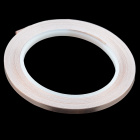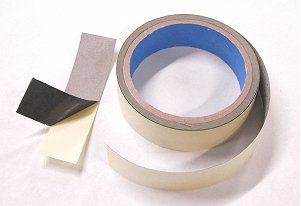The Great Big Guide to Paper Circuits
Contributors:
 Gella
Gella
Conductive Tape Traces
Conductive tape is one of the easiest ways to get started crafting a paper circuit. Just peel off the paper backing and press down where you want your circuit to go! Copper tape is also solderable, allowing strong connections between components and traces that you won't get with paint and inking methods.
Prototyping with copper tape and a SparkFun template
Difficulty: Beginner
Cost: Varies - copper tape ~$.06/ft, fabric tape ~$.79/ft
Mess Level: Minimal
Cost: Varies - copper tape ~$.06/ft, fabric tape ~$.79/ft
Mess Level: Minimal
Pros:
- No dry time.
- Solderable (copper tape only).
- Easier to find locally - copper tape is also used as a snail/slug repellent and sold in hardware stores. It is also used in stained glass making and may be available in local craft or hobby stores. Not all tapes are made alike though - these ones may be more difficult to work with and the adhesive is probably not conductive.
Cons:
- Copper tape can give you a nasty paper cut, please be careful!
- Harder to create smooth lines or shapes. You can cut the tape to a thinner width to help with this.
- Conductive fabric tape can be very expensive.
Copper Tape
Ni/Cu/Co 1" Wide Fabric Tape
Image from LessEMF.com
Less common than copper tape is a conductive fabric tape made of nickel, copper and cobalt. This tape will stand up to bending and flexing and is a great option for projects that have folds (such as cards that require traces to cross the center crease).
Instructions:
- Peel and stick where the traces should go, making sure to leave gaps in the tape where components will sit. For the most reliable circuit, try to use one continuous piece of tape between components. Use folding techniques around corners or solder pieces together as needed.
- For copper tape - use clear tape over bent leads to hold them down to the trace. Soldering is a more secure option. For fabric tape we recommend a conductive glue or sewing the connection with conductive thread.
Note how the copper tape is cut to leave room for the LED.
Examples:
This blushing robot card from Chibitronics uses thin copper tape to spell the message inside and create the circuit for the LED on the front of the card.
Jie Qi's Circuit Sketchbook uses conductive fabric tape in the book's binding and copper tape on the inside cover.
Additional Resources:
- Paper Circuits with Copper Tape - one of the original resources for working with copper tape developed by Jie Qi at MIT's High-Low Tech Lab. This site includes some printable templates and techniques.
- Getting Started with Copper Tape for Electronics - video overview of working with copper tape, making connections, and folding corners and curves.
- Soldering Conductive Fabric - tests done by Hannah Perner-Wilson of Kobakant on soldering different types of fabric.





